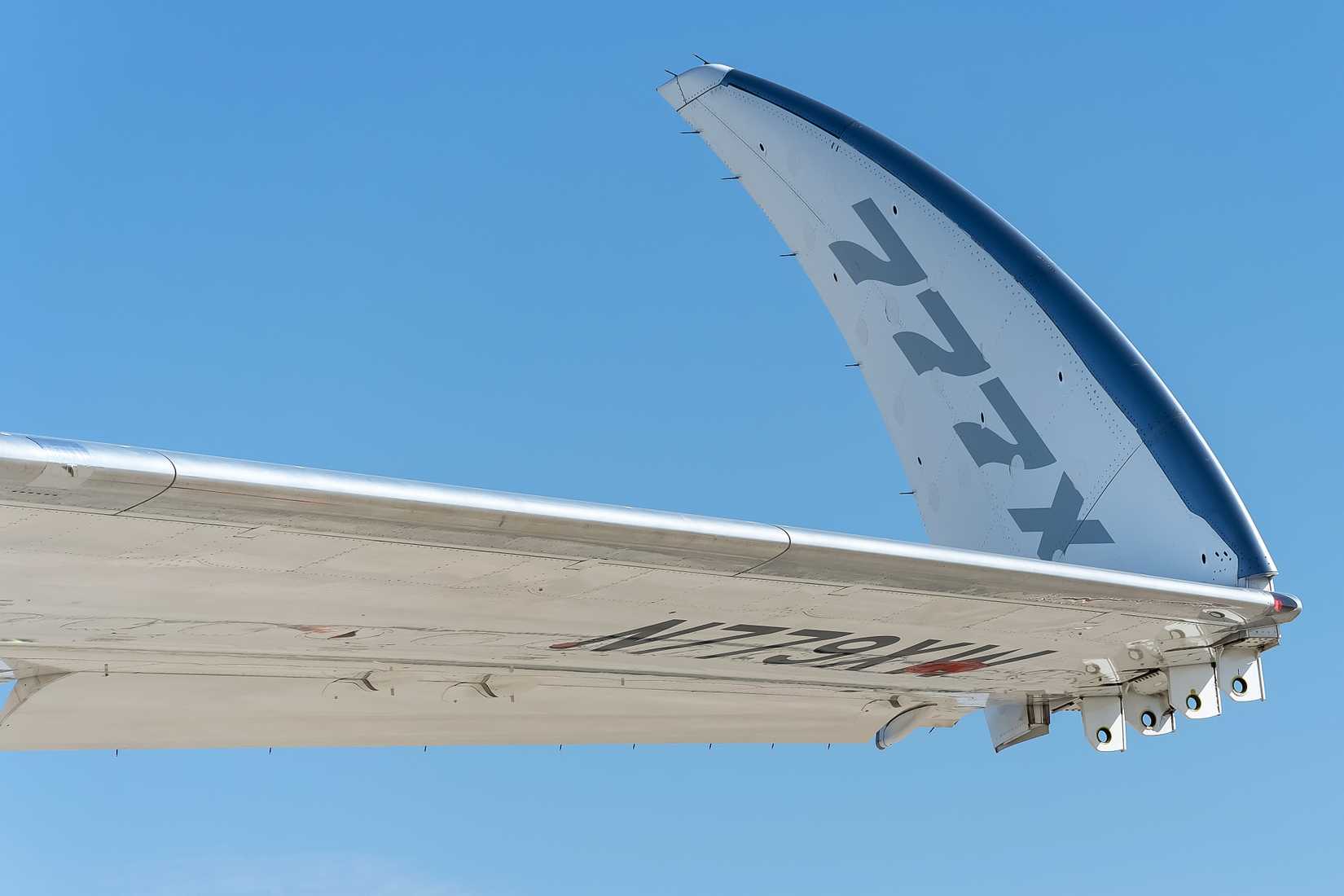The Boeing 777-8F is the freighter variant of the Boeing 777X family, a plane that is designed to replace and surpass the Boeing 777F on long-haul, heavy-cargo routes. The aircraft offers the Boeing 777X’s new carbon-fiber high-aspect-ratio wing (featuring folding wingtips) and GE9X engines that will cut fuel burn, noise, and carbon emissions per ton while preserving the Boeing 777’s volume and payload capabilities. The Boeing 777-8F offers a structural payload of around 118 tons, with a range exceeding 4,400 nautical miles. This will allow the aircraft to target lower per-tonne costs than any other twin-engine freighter in its class. The aircraft was launched in 2022 with Qatar Airways Cargo as the type’s launch customer, which placed an order for 34 jets with an additional 16 options.
- First Delivery
-
May 15, 1995
- Number Delivered
-
1,735
- Production Sites
-
Everett, Washington, United States
Boeing began early production of the aircraft starting in 2025, with the first Boeing 777-9 deliveries set to take place in 2026, followed by the 777-8F. Industry reports have indicated that the freighter’s service entry is scheduled for 2028, although multiple analysts doubt this timeline, given slow certification efforts. The aircraft’s size would pose a ground maneuverability issue if it were not for the aircraft’s retractable winglets, which have been a key selling point for the aircraft’s passenger variants. We analyze the Boeing 777-8F in detail.
A Deeper Look At The Boeing 777F
As we attempt to analyze and understand the purpose and capabilities of the Boeing 777-8F, it is important to understand the aircraft it will be replacing, the original Boeing 777F. The Boeing 777F, which is often referred to by analysts as the Boeing 777-200LRF, is the current-generation twin-engine freighter offered to the market by Boeing. The jet entered service in 2009, pairing the strengthened wings of the Boeing 777-300ER with some elements of the 777-200LR’s design. The aircraft features fuel-efficient GE90 engines with a freighter fuselage, large cargo door, and reinforced floor beams. The resulting aircraft is a long-range, high-payload workhorse that delivers widebody volume with the economics of a twin-engine aircraft.
The aircraft slots below the Boeing 747-400F in terms of sheer capacity, but it beats most four-engine freighters in terms of trip costs and fuel burn per tonne. The aircraft’s hallmark is its flexibility, as it can haul heavy general cargo and pharmaceutical products over large intercontinental stages without the need for a technical stop. The aircraft’s operators value commonality with large-scale passenger Boeing 777F fleets, which lowers the lifecycle costs and supports high dispatch reliability.
FedEx, Qatar Airways Cargo, Lufthansa Cargo, and Air France/KLM are among the aircraft’s biggest users, and they often schedule the type to work on their highest-demand trunk routes, recognizing its range, speed, and reliability. The aircraft also exemplifies the industry’s shift toward efficient twin-engine aircraft as classic Boeing 747s retire, with the plane slotting above Boeing 767 and Airbus A330 freighters in terms of overall payload. However, the aircraft has slowly become outdated, and major cargo operators are looking for a plan that offers next-generation economics.
The Development Process Of The Boeing 777F
![]() Boeing launched the Boeing 777-8F in January 2022, when it unveiled a freighter that was built on the Boeing 777X platform, an aircraft with a high-aspect-ratio that features folding wingtips and GE9X engines. The aircraft was to be the key successor to the Boeing 777F. Qatar Airways Cargo became the aircraft’s launch customer, and Cargolux soon inked an order for ten aircraft that would replace its aging Boeing 747-400F fleet, helping to anchor early demand for the model. The development of this model has proceeded in lockstep with the Boeing 777-9’s certification effort.
Boeing launched the Boeing 777-8F in January 2022, when it unveiled a freighter that was built on the Boeing 777X platform, an aircraft with a high-aspect-ratio that features folding wingtips and GE9X engines. The aircraft was to be the key successor to the Boeing 777F. Qatar Airways Cargo became the aircraft’s launch customer, and Cargolux soon inked an order for ten aircraft that would replace its aging Boeing 747-400F fleet, helping to anchor early demand for the model. The development of this model has proceeded in lockstep with the Boeing 777-9’s certification effort.
The key certification challenges for the Boeing 777X program lie with a few key aerostructures and engine approval, both of which have faced timeline delays. The freighter’s unique items, specifically the aircraft’s main-deck cargo loading door and floor reinforcements, will likely also proceed in parallel. Schedule resets on the Boeing 777X could hold the program back, and Boeing has already noted that it expects the aircraft’s service entry to be in 2028, already pushing back from an initial 2027 target.
Despite these challenges, the production process began this year at Boeing’s factory in Everett, Washington. The broader Boeing 777X timeline remains an item that faces regulatory scrutiny, and the plane has not yet achieved many of its major milestones. Nonetheless, the manufacturer’s order book continues to expand as cargo airlines lock in next-generation capacity ahead of the jet’s late-decade entry into passenger service.
Why Did Boeing Decide To Build The Boeing 777-8F?
Boeing built the Boeing 777-8F primarily to extend and defend its dominance in the large twin-engine freighter market. The aircraft is hitting the market at the ideal time to make a major impact. Currently, hundreds of Boeing 747-400F and Boeing 777F models are beginning to age, and belly cargo capacity has slowly become more and more volatile. Operators want a high-payload twin-engine aircraft that offers lower fuel burn in order to anchor their high-capacity cargo routes for decades to come.
Second, the airline industry faces regulatory and economic hurdles, with the global demand for carbon dioxide continuing to tighten. Airlines face higher costs and want more efficient engines, something that the Boeing 777-8F brings to the table through next-generation efficiency and its compact high-aspect-ratio wing design, making the plane more attractive than some legacy models. The aircraft is a key element of Boeing’s vision to remain a dominant player in the long-haul freighter market for decades to come. Here are some specifications from the manufacturer Boeing:
|
Category: |
Boeing 777-8F Specification: |
|---|---|
|
Total Pallet Capacity: |
44 pallets |
|
Height: |
64 feet (19.51 m) |
|
Range: |
4,410 nautical miles (8,170 km) |
The aircraft is not as capable as a Boeing 747 freighter, especially when compared to the Boeing 747-8F, which has slowly become the flagship freighter for most major cargo operators. Nonetheless, the aircraft continues to offer airlines a choice of twin-engine, capable models that can fly across the globe with heavy payloads, increasing gauge over the Boeing 767 or Airbus A330 family freighters.
A Deeper Look At The Boeing 777-8F’s Primary Competition
The Boeing 777-8F and the Airbus A350F are preparing to square off at the top of the twin-engine freighter market, although the two aircraft do lean on some different strengths. The Boeing 777-8F’s strength lies in its impressive payload and its commonality with the rest of the Boeing 777 family. The GE9X offers impressive power, and the aircraft features a large enough cross-section to provide customers with the cargo capacity they need.
The Airbus A350F boasts a lower structural weight and features a composite fuselage and wing, complemented by the Rolls-Royce Trent XWB engine, which offers impressive performance. The aircraft aims primarily to win on per-tonne operating economics and compliance with emissions guidelines. In terms of network design, the Boeing aircraft is better suited to dense, heavy cargo routes where payload and volume matter most.
The Airbus A350F is suited for routes where unit costs and daytime slots are limited. Aircraft lessors typically prefer the Airbus A350F’s lighter and more versatile operating economics, while incumbent Boeing 777 operators favor the aircraft’s existing compatibility with its pilots and maintenance system. Both aircraft are expected to coexist in the market within just a couple of years.
Where Will We First See The Boeing 777-8F?
As has already been noted, the Boeing 777-8F is set to enter service first with Qatar Airways Cargo, the aircraft’s launch customer that placed 34 firm orders for the type. The aircraft fits well with the Qatar Airways fleet, as it is very effective at operating long-haul, high-capacity cargo routes. The airline’s massive hub-and-spoke cargo network, which originates at Doha Hamad International Airport (DOH), is well-tailored to this kind of aircraft.
The aircraft’s timeline remains a topic of heated discussion. Current timelines point to the first aircraft deliveries taking place in 2028, after a one-year slip from the manufacturer’s original targets.
The aircraft will likely first enter service on high-volume trunk routes, although Qatar Airways (nor any other operator) has announced the inaugural deployments for the model. The airline’s choice of the Boeing 777-8F over the A350F highlights the carrier’s recent preference for the Boeing 777, given high-profile disagreements with the European manufacturer.
What Is The Bottom Line?
While most media attention is drawn to high-profile passenger aircraft orders, it is important to keep in mind that cargo aircraft are a key element of any manufacturer’s order book. Boeing is naturally no exception.
The manufacturer has been a dominant player in the long-haul cargo aircraft market for years. Specifically, the carrier has produced highly successful freighters like the Boeing 747F, Boeing 767F, and the Boeing 777F, all of which have become bestsellers.
Boeing has long-time customers who are looking for a Boeing freighter to replace their aging aircraft. This demand in the market ultimately pushed the manufacturer to develop its best-in-class next-generation product.








